On my very last day in Rome I checked out of my hotel, stored my luggage, and hopped on the subway to the Vatican, bound for the Sistine Chapel. Unfortunately, the Sistine Chapel has been closed for the past two days for some important religious holiday, so on the day it reopened there was a backlog of tourists anxious to see this site before leaving the Eternal City. By the time I arrived the lines wound around the Vatican Museum and down the street, nearly to the entrance of Saint Peter’s Basilica.
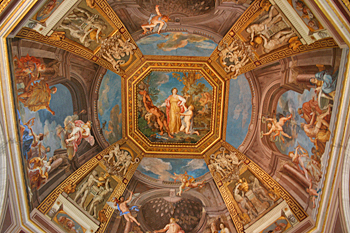
For two and a half hours I stood on line, baking under a brutal August sun, buckets of sweat pouring off me. When I finally reached the entrance there was another line to buy tickets – 13 Euros (about $17 US) gained me entrance to the Vatican Museums, the courtyards, the grounds, the numerous historical rooms inside the Vatican leading to the Sistine Chapel, and to the Chapel itself. Past the ticket booth the traffic thinned out a bit and I breathed a sigh of relief – I do not do well in large crowds for lengthy amounts of time, as I seem to have a hard time shielding myself from the energy of all those people in one place at the same time. I followed the signs and climbed the stairway to the upper level, only to encounter another mad crush of people at what appeared to be the entrance to the Sistine Chapel. It turned out to be the entrance to the route LEADING TO the Sistine Chapel. During the ensuing two hours I plodded through endless corridors leading to scores of chambers with walls and ceilings covered in frescoes.
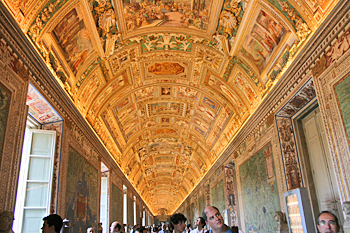
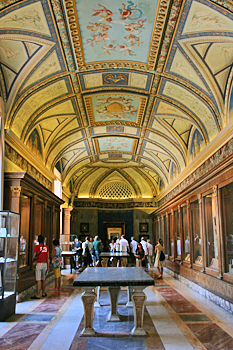
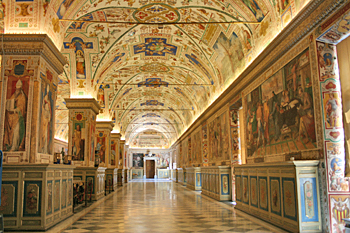
Interspersed between these intricately decorated rooms were storerooms containing shelf after shelf of sculpture – the room of animals, the room of marble heads, etc. At intervals the tour route passed through gift shops selling religious medals, jewelry, books (two of these), art reproductions, Pontifical memorabilia, antiques, and various and sundry other useless trinkets. (Does anybody really BUY this stuff?) I JUST WANTED TO SEE THE SISTINE CHAPEL, FOR PETE’S SAKE!
FINALLY – we reached the Chapel itself. I stepped into the room, and my jaw dropped open in astonishment at the exquisite works of art surrounding me. I raised my camera to take a photo of the famous ceiling, painted by Michelangelo and one of the guards yelled at me, “No photos, no photos!” while pointing to a sign that clearly showed a camera with an ‘X’ through it. Let me get this straight, I thought. I have spent four and a half hours and $17 to get here and, although I can take photos of all the art anywhere else in the Vatican, I can’t take a photo of the Sistine Chapel? Something’s rotten in Denmark – or in the Vatican, in this instance. It didn’t take me long to figure out that they don’t want you to take photos because they want you to BUY their art reproductions.
I walked away from the guards and into the center of the Chapel, carefully perusing the situation. There were just a few guards and hundreds of people – there was no way they could keep an eye on everyone. Plus, my camera has a ‘no flash’ setting, so there was no chance that any photo I took would harm these art treasures. I thought, ‘What’s the worst that can happen?’ They could delete the photos from my camera, in which case I’d just be back where I started. Or they could throw me out, which, frankly wouldn’t be so bad at that point because I’d seen what I came for and if they escorted me out I’d probably bypass all the crowds. So I hunkered down, eyeballed the guards, and when they weren’t looking, surreptitiously took whatever photos I could.
This photo is taken from the end of the Sistine Chapel, looking back at the altar wall, above which is painted Michelangelo’s famous mural, The Last Judgment:

Michelangelo began working on The Last Judgment in 1535, three decades after finishing the ceiling of the chapel, finishing it six years later. This giant mural is a depiction of the second coming of Christ and the apocalypse. The souls of humans rise and descend to their fates, as judged by Christ and his Saintly entourage. The painting technique employed was fresco, in which paint is applied directly to damp plaster that was laid in a new section each day, the edges from the previous day first being scraped away. Michelangelo preferred the fresco technique to working on dry plaster, where every brushstroke sank in immediately and the pigment could not be manipulated without removal of the plaster. The disadvantage of fresco painting is that the plaster becomes very hot while it is setting and gives off fumes. I also managed to get a close-up shot of The Last Judgment, which is stunningly beautiful. It is hard to believe that it is nearly 500 years old:

The Last Judgment was an object of a heavy dispute between Cardinal Carafa and Michelangelo. Having depicted naked figures with genitals in evidence, the artist was accused of immorality and obscenity and a censorship campaign (known as the “Fig-Leaf Campaign”) was organized to remove the frescoes. When the Pope’s own Master of Ceremonies, Biagio da Cesena, said “it was most dishonest in such an honoured place to have painted so many nude figures who so dishonestly show their shame and that it was not a work for a Chapel of the Pope but for stores and taverns” Michelangelo worked da Cesena’s semblance into the scene as Minos, judge of the underworld. It is said that when he complained to the Pope, the pontiff responded that his jurisdiction did not extend to hell, so the portrait would have to remain. The genitalia were later covered by the artist Daniele da Volterra, whom history remembers by the derogatory nickname ‘the breeches-painter.’
Along the north and south walls of the Chapel and just beneath the famous ceiling are a series of frescoes, painted by some of the world’s most famous Renaissance painters, including Botticelli, Ghirlandaio and Perugino, and a set of tapestries by Raphael. These depict the life of Christ and are startling in their use of colors so vivid that, in my opinion, they very nearly eclipse the ceiling itself. I was able to take a photo of three of these frescoes:
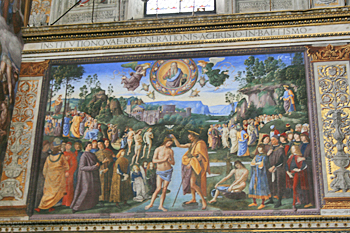
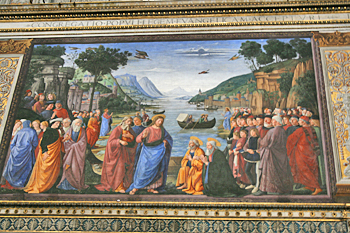
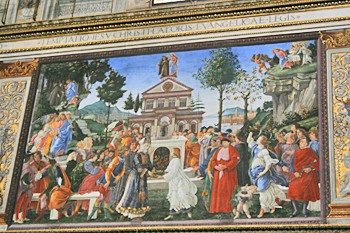
Finally, there is Michelangelo’s ceiling, painted between 1508 and 1512, and considered to be one of the most renowned artworks of the High Renaissance. Central to the mural are nine scenes from the Book of Genesis, of which the Creation of Adam is the best known. The entire mural revolves around this most widely recognized image in the history of painting, where Michelangelo shows God reaching out to touch Adam:
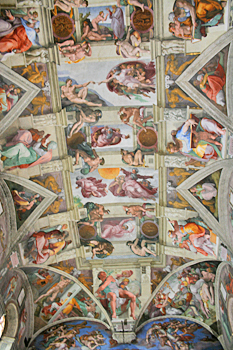
In order to reach the chapel’s ceiling, Michelangelo designed his own scaffold, a flat wooden platform on brackets built out from holes in the wall near the top of the windows. Contrary to popular belief, he painted in a standing position, not lying on his back. My neck got sore just from looking up at the mural for a few minutes – I simply cannot conceive of how Michelangelo was able to paint this entire mural while tilting his neck back far enough to see the ceiling!
So, was it a tourist trap? Yes. Would I do it again, despite the crowds and stress? Yes, absolutely! There are some things that are just worth the trouble.

I hated the long winding route that they make you take to get to the Sistine Chapel. I was there during November and it was incredibly busy, I can only imagine what it was like after being closed for a couple of days in the middle of tourist season! There was just too many people to fully explore the museum and appreciate the fantastic art that you’re surrounded by. I went in 2008 and wasn’t allowed to take photos either. I wasn’t brave enough to attempt it! You got some great shots that really demonstrate the beauty to be found in the paintings.
The ceiling of the Sistine Chapel was restored by a Japanese firm and THEY own the rights and prevent photographs. The Raphael’s are in a room you apparently rushed through, one of them is his masterpiece. When you go back, take your time. The chapel is only the icing on the cake of an incredibly delicious museum.
I would hardly say I rushed through, Forrest. I spent two hours in line waiting to get in and then the rest of the morning and most of the afternoon inside. But the crowd was so huge that I could hardly see anything, much less enjoy it. Cattle drive, pure and simple.
Beautiful… One day will visit! 🙂
It is beautiful, Mo. Just go in the off-season to avoid the largest crowds.
Visit Rome in January. Yes, it is cold but all the museums are empty. I stood in the Sistine Chapel all by myself for three hours last January. Beautiful.
I was there two weeks ago. I noticed how hundreds of people were using flash throughout the Vatican museums. I too wondered how a non-flash setting could destroy the artwork on the ceiling. In the Sisten I took a blurred photo with camera pointing upwards from stomach height. A heavy hand on my shoulder and a plain-clothes security guard showed me his ID and said “out”. I put my camera away and said sorry, he said “out” again. I explained they had people in all the other rooms taking pictures with flash right in front of security guards although flash was banned. He said “no English, out”. A security guard in uniform grabbed my arm and I was marched out through a side door. It may be because I am English and the old “England vs Pope” arguments, anyway, until they reverse this daft ban I’d advise on a boycott.
Yes, and I was particularly put off by the route of the tour, which led us past every shop in the place selling icons and religious memorabilia. I’m surprised more people don’t faint in the heat and crush of the crowd.
Hi, sorry but what you’re writing is wrong. There is no fresco made by Raphael in the Sistine Chapel! Why do you write information that are being taken out from the moon?!? Raphael was born in 1483 and the paintings in north and south walls were executed between 1481-83. These frescoes were painted by Perugino, Botticelli, Biagio d’Antonio, Signorelli, Ghirlandaio and Roselli.
I’ve seen Sistine Chapel in the movie and I told myself… I will step into that church one day. The theme is mesmerizing, the art is outstanding. I can’t even concentrate in one particular place because everything is awesome…
and for Christ Sake… i was just looking at a book!
what for if it is for real… duh!
They’re the most beautiful wall paintings I’ve seen. Thanks for sharing your views.